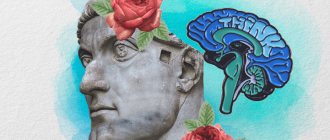Sleepwalking (somnambulism) is a condition in which a person can walk and perform some actions in his sleep. In this article you will find interesting facts about sleepwalking; we will talk about the reasons for this behavior, its dangers and whether sleepwalking can be cured.
Previously, it was believed that sleepwalkers were influenced by the phases of the moon, hence the popular name for somnambulism - “sleepwalking.”
What it is
No matter how they call it, a sleep disorder occurs when a person is asleep and at this time walks around the room and speaks. Scientifically, sleepwalking is called somnambulism. It was believed that people who spoke or walked in their sleep were affected by the forces of the moon. Hence the name sleepwalking, which is firmly attached to the disorder. Most often it manifests itself in children as a result of mental imperfections.
By the end of adolescence, sleepwalking occurs less frequently. They first learn about it from the 8th grade Biology textbook. It gives a definition of somnambulism, which is classified as a sleep disorder. And the medical term is translated as sleepwalking. Childhood sleepwalking is more common.
It occurs less frequently in adults, and men suffer from it. It can be episodic, repeating 1-2 times a month under a certain condition. But when cases of somnambulism are repeated regularly, then they talk about a serious illness that needs to be treated.
Who is at risk?
Scientists have concluded that somnambulism is much more common in childhood than in adults. To determine this, a study was conducted that followed 1,400 Canadian children. According to the results of the experiment, the proportion of sleepwalking children increases from 2.5 to 10 years, and gradually decreases from 12 years. During adolescence, the disease goes away and persists in only a few. Sleepwalking affects 2–4% of the adult population, about a quarter of them have been ill since childhood, the rest acquired this disease later.
It is currently unknown why sleepwalking goes away with age in some people and remains in others.
One of the significant reasons for sleepwalking is considered to be a hereditary predisposition, especially if both parents were somnambulists
Psychological view of the nature of sleepwalking
People susceptible to somnambulism are, as it were, in a state of hypnosis, between sleep and wakefulness. According to the statements of Academician I. Pavlov, protective inhibition in sleepwalkers extends only to the cerebral cortex. Subcortical structures are not protected. The cortical centers responsible for coordination of movements remain active.
Since the somnambulist is well oriented in space, his visual and sensitive analyzers are involved. But control of actions is not carried out during sleepwalking, since the sleeping cerebral cortex inhibits this activity of the sleepwalker. Complete or partial amnesia after an attack is typical.
It is interesting that during an attack a somnambulist has qualities that he does not have in real life. He can draw a picture, sing, write a poem. Mutations that arise in information blocks formed in the human mind lead to changes in the behavior and character of the sleepwalker.
Observing patients, physiologist I. Mechnikov wrote that mechanisms inherited from ancestors are usually inhibited by the brain. And when sleepwalking occurs, they disinhibit. A person begins to perform such dizzying stunts in a dream that he would not dare to do in life. Not realizing the danger, the sleepwalker walks along the edge of the roof, the cornice of the window, and moves freely along a thin beam thrown from balcony to balcony.
Moonlight, which is associated with the occurrence of somnambulism, plays the role of an irritant leading to the disinhibition of areas of the brain responsible for movement. The trigger mechanism for performing actions in a dream for a sleepwalker will also be any sound, the light of a light bulb, a lantern, or changes in air temperature.
Why does it occur
If a child begins to sleepwalk due to increased susceptibility to external factors, then in adults somnambulism is associated with:
- exhaustion of the nervous system due to chronic lack of sleep;
- neoplasms in parts of the brain;
- obsessive states;
- chronic form of epilepsy, Parkinson's disease;
- disorders of the autonomic systems;
- difficult pregnancy;
- improper lifestyle, nutrition;
- emotional excitability, increased impressionability;
- taking medications, drugs,
- chronic alcoholism.
The causes of sleepwalking in adults lie in prolonged depression, when a person is constantly tense, he has nightmares, leading to walking and screaming in his sleep. In most cases, sleep disorders are inherited. If at least one parent suffered from sleepwalking, the disease will manifest itself in children.
Drug treatment
According to individual indications, the patient may be prescribed sedatives or sleeping pills, and in some cases tranquilizers are used. The choice of drug therapy is a very important moment; the specialist takes into account many factors before prescribing this or that drug.
If the patient has vascular, neurological, endocrine or cardiac diseases, therapy focuses on treating the underlying disease. For example, if the cause of sleepwalking is attacks of severe arrhythmia, then it is the heart disease that should be treated. In cases where the problem is caused by brain tumors, surgery will likely be required.
Mainly during treatment, it is important to create conditions under which a person will feel calm and confident. You can relieve fatigue and anxiety using physiotherapeutic methods and relaxation practices.
Types of somnambulism
Types of sleep disturbance are associated with the causes of its occurrence in adults:
- Those who have drunk a lot of alcohol walk and talk sporadically. Visions arise in the foggy brain of a drunken man, he fights with invisible forces. Alcoholic sleepwalking occurs in men in most cases.
- People who are sexually anxious suffer from this disorder. Their actions are aimed at satisfying their sexual instincts. They worsen after alcohol.
- A harmless manifestation of the disorder when talking or singing in a dream occurs at any age. Talking in a dream is harmless and goes away on its own without treatment.
- An interesting, but at the same time dangerous form of sleepwalking is associated with attacks of hunger. A person begins to eat and drink everything without waking up. It is necessary to monitor the sleepwalker to prevent poisoning if he turns on the gas stove.
- There are cases of disorder when a person is so devoted to dreams that he begins to act in accordance with them. When jumping from a height, a sleepwalker can fall to his death, and if he grabs a bladed weapon, he can harm the health of others. There are various examples of manifestations of the disorder that are dangerous both for the sleepwalker himself and for those around him.
Not only somnambulists themselves, but also other people can suffer from sleepwalking. Waking a person in this state is difficult and sometimes dangerous.
Features of the attack
During sleepwalking, the brain of a sleepwalker reacts to sounds and objects. It happens that the patient turns on the light, opens the window, and orients himself well in the apartment. At the same time, the person looks strange outwardly. His eyes are open, but his gaze is glassy, expressing nothing. Waking a sleepwalker is dangerous. He may become very frightened and become stressed.
After a sharp awakening, the sleepwalker’s thoughts are confused and he is disoriented. After all, after a special mental state, it is difficult to return to reality. Episodes of somnambulism are associated with the deep stage of sleep. In this case, the inhibition processes do not affect the parts of the brain responsible for motor activity. The attack lasts from 3 seconds to 30 minutes.
Sleepwalking attacks are provoked by:
- asthma;
- short-term cessation of breathing;
- reflux of food from the stomach into the esophagus;
- increase or decrease in blood pressure;
- arrhythmias.
The attack of somnambulism ends as suddenly as it began. Therefore, a sleepwalker is surprised when he wakes up on the bathroom floor or in another room. It’s scary when a sleepwalker gets his hands on a gun or a knife. There are cases when people kill in a somnambulistic state without realizing their actions. The rarity of such facts is noted, but they should not be completely excluded.
Interesting cases of somnambulism are described in I. Mechnikov’s book “Studies of Optimism.” The somnambulist’s movements are automatic, her eyes are open, her hair is loose. It was not for nothing that sleepwalkers were mistaken for ghosts and compared to witches.
Pathogenesis
There are two stages of sleep - fast and slow sleep. In the rapid stage, a person's eyes move under the eyelids. NREM sleep is divided into several stages: the process of falling asleep, light sleep, deep NREM sleep, especially deep sleep. If the deep sleep stage is suddenly disrupted, a person may perceive reality incorrectly and have difficulty concentrating. In this case, they talk about confused awakening or sleepy intoxication syndrome. In this state, a person may behave unusually. If at the same time he leaves the place where he slept, then such an episode is defined as sleepwalking.
REM and NREM sleep cycles alternate, with each cycle lasting approximately an hour and a half. Longer periods of slow-wave sleep are observed in the first half of the night, longer periods of fast sleep are observed in the second half. Episodes of sleepwalking usually occur during periods of deepest sleep, which is noted in the first third of the night. At the same time, the human brain is in a transitional state between wakefulness and sleep.
Scientists do not yet know why in some people such manifestations disappear with age, appearing only in childhood, while in others they do not.
Who to contact, diagnostics
People suffering from somnambulism do not always consult a doctor. For occasional violations this is not necessary. But constant sleepwalking with a variety of activities needs to be treated. After all, the consequences of the disease will be unpredictable. In a sleeping state, a sleepwalker is dangerous. He can hurt himself, his family, or turn on the gas.
For a regular disorder, it is best to record the time when the patient begins to walk and describe his actions. This can be done by a loved one who monitors the progression of sleep disorders. The diary includes how the sleepwalker eats and what medications he takes.
When you come to an appointment with a neurologist, psychiatrist, psychotherapist, or somnologist, you need to be prepared to undergo diagnostics in the form of:
- electroencephalogram of the brain;
- computed tomography or resonance tomography, detecting tumors of the meninges;
- Ultrasound of blood vessels;
- polysomnogram, which records impulses occurring at night using sensors.
By processing on computers the results of breathing sensors, heart function, electrical impulses in the muscles, processes in the neurons of the brain for 8 hours, conclusions are drawn about the course of sleep. With somnambulism, like parasomnia, behavioral disturbances occur at one of the stages of sleep or during the transition from one phase to another. The patient also needs to consult a pulmonologist, cardiologist, or endocrinologist to determine the causes of the disease.
Interesting Facts
In the USA, Ron Whitehall, while sleeping, began to strangle his wife sleeping next to him. It turned out that at that moment the man was having a dream where he was attacking a snake. Fortunately, this episode of sleepwalking ended favorably. The wife remained alive.
Russian scientist L. Vasiliev believed that stories about the brownie appeared because of people with somnambulism. In his opinion, people perceived the noise coming from sleepwalkers as the antics of mystical creatures.
Several murders were committed while sleepwalking. In 1845, American Albert Tyrell killed his mistress with a straight razor and tried to set her house on fire. Moreover, he did all this unconsciously. The morning after this incident, the man woke up in his own bed covered in blood. At least that's what Tyrell claimed. The killer learned about the committed act from a newspaper. It is noteworthy that the jury acquitted Albert. Perhaps the acquittal was influenced by the fact that Tyrell was an official.
A similar murder occurred in 1985 in Canada. Kenneth Parks, while sleeping, got out of bed, got dressed and headed to his mother-in-law's house. After breaking down the door, Kenneth went up to the bedroom and began beating the woman until she died. The father-in-law sleeping next to him also got it, and Parks began to choke him. The man lost consciousness but survived. The killer surrendered to the police, but the court initially did not acquit Kenneth. Only after 3 years in prison was Parks released. Lawyers were able to prove that the murder was completely asleep. Psychologists who worked with Kenneth found out that this incident was a consequence of his dismissal from work, which occurred the day before the crime.
A case of sexual sleepwalking occurred in the Canadian city of Toronto. The guy drank alcohol at a house party and fell asleep on the couch. At the end of the festivities, the guests went to their rooms, leaving the young man on the sofa. In the morning, his friends woke him up and told him that he had raped one of the girls who came to the party. The guy didn’t believe this and replied that he didn’t remember anything about what happened that night. The case went to trial, but the young man was acquitted.
Solutions
It is necessary to combat sleepwalking by identifying the cause of the pathology. After treatment for diseases of the heart, blood vessels, respiratory system, diabetes, the symptoms of somnambulism disappear. Sleepwalking does not go away when it is caused by disorders of the nervous system. Mental disorders can be cured using traditional methods and folk remedies.
Traditional methods
It is necessary to use tablets for somnambulism when sleepwalking poses a danger to the patient himself and his environment. Pharmacy medications include antidepressants, sedatives, and sedatives. Tranquilizers are prescribed for patients.
Weekly courses of Clonazepam or Nitrazepam one hour before bedtime are effective. After taking medications, it is possible that sleepwalking attacks will go away for a while. But they can return again under certain situations. You can completely get rid of sleepwalking using additional methods.
Relax with folk remedies
A disease associated with nervous overstrain can be cured by relaxation methods. Taking baths with essential oils of mint, lemon balm, sweet clover, and sage before bedtime relieves nervous tension and allows you to sleep deeply and peacefully. Signs of sleepwalking are eliminated within 10-15 procedures. The temperature of the water in the bath is 36 degrees, the residence time is 10-15 minutes.
If a person suffers from a sleep disorder due to depression or increased nervous excitability, then you can take the following infusion before bed:
- spring primrose flowers;
- lemon balm;
- blue cyanosis rhizomes, a tablespoon 2 hours after eating;
- hop cones;
- peppermint.
Yoga classes under the supervision of a specialist are very calming.
Diet
Diet for the nervous system
- Efficacy: therapeutic effect after 2 months
- Timing: constantly
- Cost of food: 1700-1800 rubles per week
Both adults and children who experience such manifestations should eat properly and rationally. The diet should be varied. It is advisable not to consume alcohol. Also in the afternoon you should not drink drinks that stimulate the nervous system. It is worth giving up tea and coffee.
How to Avoid Injury
In families where a sleepwalker lives, measures must be taken to avoid the dangerous consequences of sleep disturbance. For this they try:
- monitor the behavior of the somnambulist;
- block doors;
- put bars on the windows;
- cut off sharp corners on tables;
- remove chairs and breakable objects at night;
- Do not scatter electrical wires around the room;
- hide small items, keys.
If it is difficult to keep track of the sleepwalker, then it is better to call an ambulance in case of injury or a dangerous situation.
Prevention measures
People often don’t know what to do when they sleepwalk regularly. If an attack occurs without physical activity, you can prevent its occurrence by relaxing with exercises or taking a bath before going to bed. Before going to bed:
- ventilate the bedroom;
- walk or perform simple physical exercises in the fresh air;
- prepare themselves for bed by turning on relaxing music and reading a boring book.
You can't let the light or loud sounds of the TV disturb your sleep. Stimulating drinks and alcohol lead to somnambulism. I wonder if sleepwalking can be cured or if you will have to live with it permanently. Scientists believe that sleepwalking stops over time. It almost never occurs in older people.
It is impossible to unequivocally answer the question of why people sleepwalk at night. There are many reasons, each individual has their own. Only a specialist can determine them. It is imperative to contact him if the violation occurs regularly and poses a danger to life and health. After conducting a test, psychologists identify the cause of somnambulism and give advice on how to get rid of it.
In children
If a child is prone to sleepwalking, parents should behave appropriately during such episodes. If the baby tries to go somewhere, he should be calmly escorted back to bed. Interrupting his sleep should only be done as a last resort. However, you can talk to your child quietly and calmly.
It is also important to avoid conflicts in the family and try to create a trusting and warm atmosphere.
Finally, parents should not perceive their child's sleepwalking as something scary. It is important to carefully monitor him, analyze the situation, and it is quite possible that the baby will “outgrow” this disease.










